Creation of assessment by criteria
To create and configure the assessment questionnaire, create a task and assign it to respondents, LMS Collaborator uses the assessment wizard. The wizard allows you to prepare and launch the assessment step by step from one page.
The tool divides the process of preparing and launching the assessment into 4 consecutive stages:
- assessment description;
- parameters setting;
- task creation;
- user assignment.
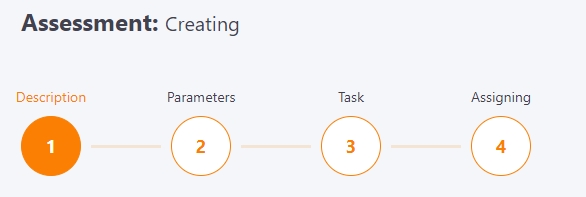
All stages can be completed sequentially using the wizard, or you can save the data at any of the stages and return to the process of preparing and running the assessment later.
To evaluate staff, you need to go to the Assessment- Assessment section. The page will display a table with a list of assessment resources (Find more in Assessment table).
You can run the wizard and create a new personnel assessment using the Create button.

Stage 1 - Description of the assessment
The first step in creating an assessment is to fill in the description. The following fields are available for filling:
(1) Title - required field;
(2) Assessment description - optional field, displayed in the table with the list of created assessments along with the title.
(3) Instructions for questionnaire responders - an editor to prepare instructions for respondents who will complete the assessment questionnaire. The instructions will be displayed before the start of the questionnaire. Standard text editing and formatting tools are available, and images can also be used in the text. They can be attached using the appropriate button Upload file (4), allowed formats: jpg, png, jpeg, gif, svg.
(5) Tags - additional parameter for grouping and searching assessments.
(6) Image for task card - an image that will be used in the task card instead of the standard one.
(7) Next - button for switching to the stage of setting the evaluation parameters. The button becomes available after filling in the required fields.
(8) Cancel - exit the page of creating an assessment description without saving.
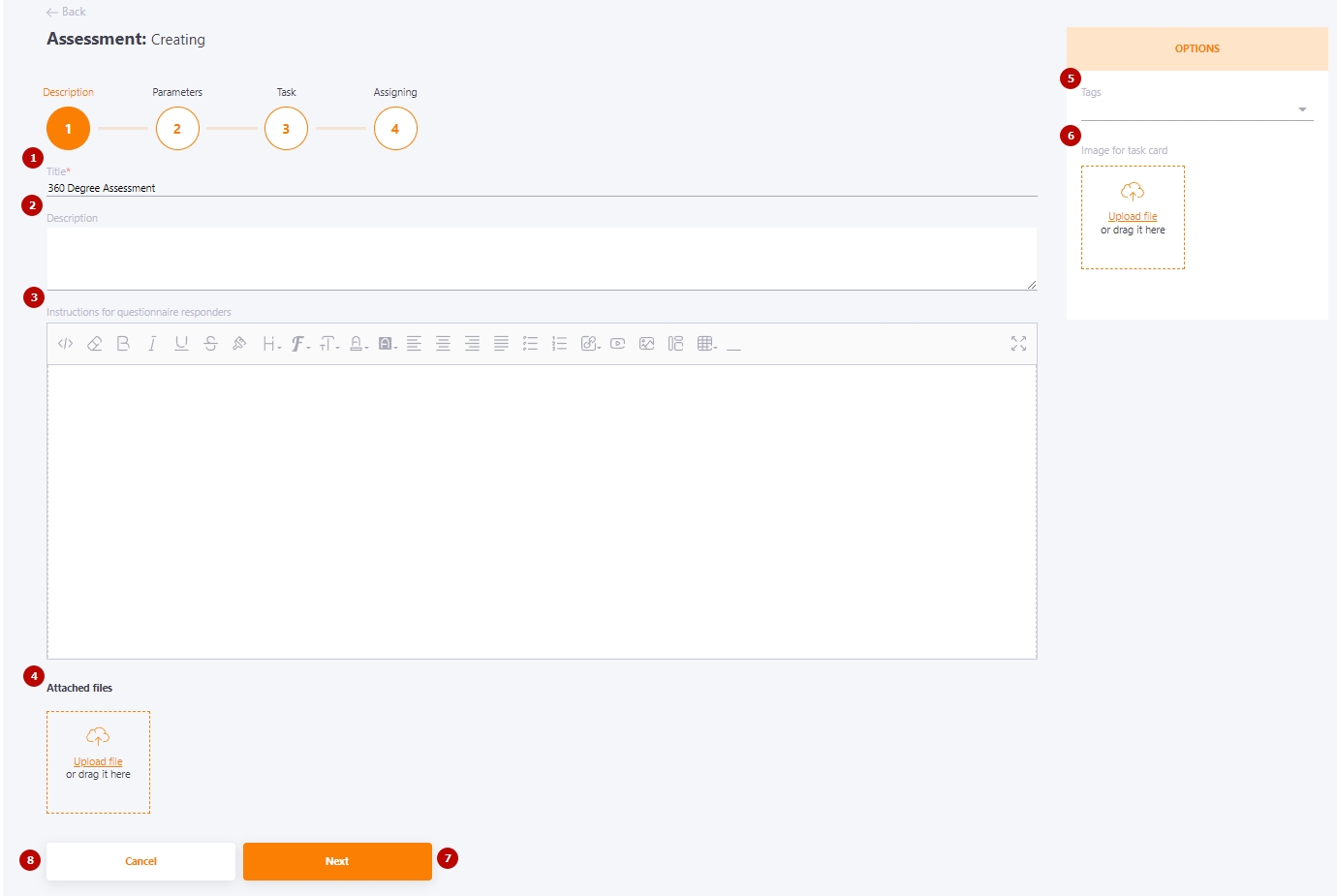
Stage 2 - Setting up the evaluation parameters
Stage 2 of the assessment creation - adding a rating scale and setting up criteria.
(1) - selecting the Assessment Type: By criteria.
(2) - You need to select a previously created Evaluation scale from the drop-down list.
If the numerical value 0 is used in the selected scale, then an additional Option appears: value 0 means no rating (4). This option should be used if you want to use the "don't know"/"can't answer" option in the assessment. This option should be assigned a value of 0 in the scale. If the setting "0 means no rating" is enabled, then the "Don't know" answers will not affect the overall score.
(3) - button for enabling mandatory commenting of criteria groups (for example, to give arguments on the setted criteria value).
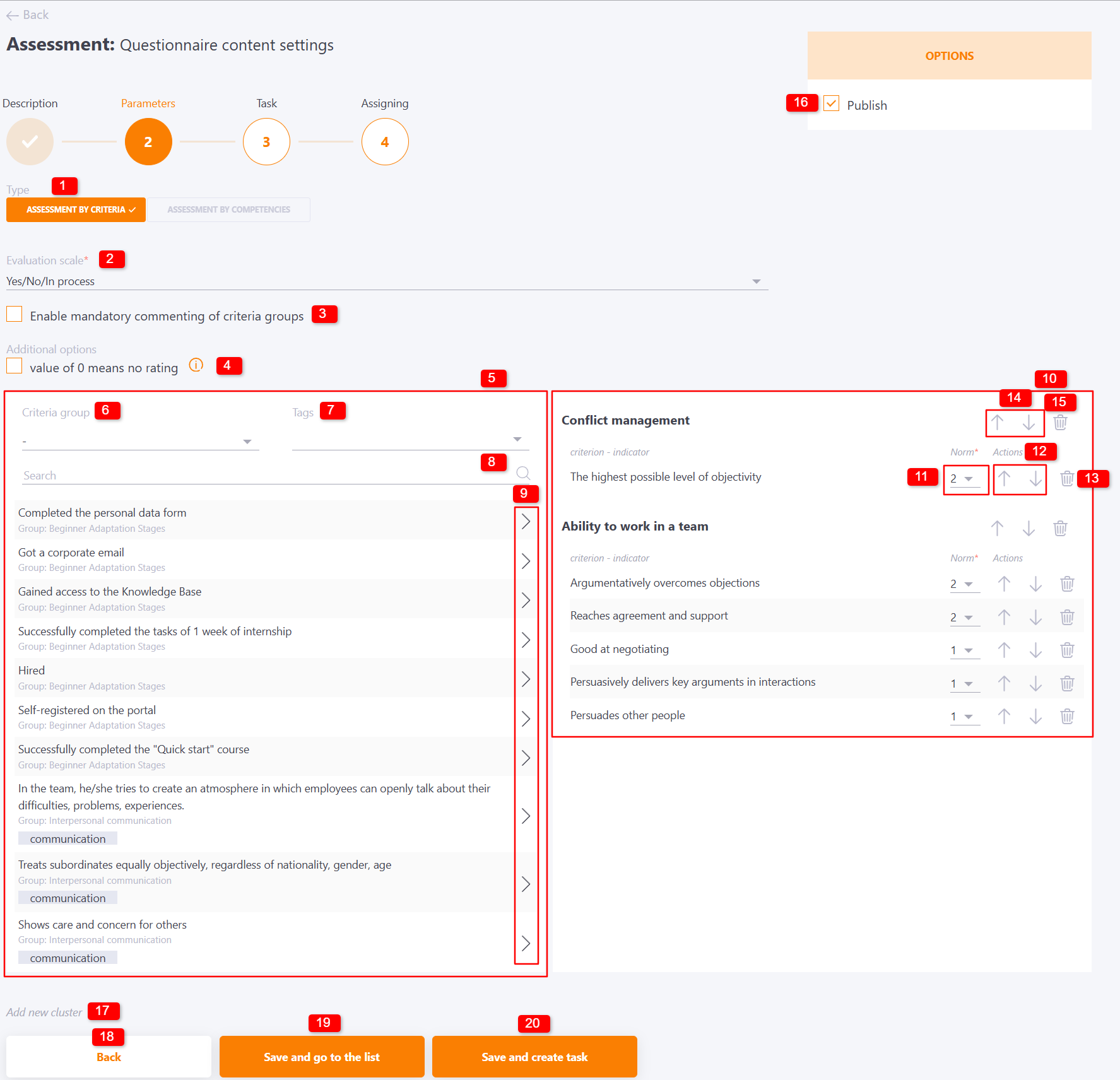
Next, you need to select the criteria-indicators that will be evaluated in the evaluation questionnaire. In the block Criteria groups (5) you can use the filter by criteria groups (6), by Tags (7), as well as use the Search by title line (8) to find the required criteria. By clicking on the arrow (9) the selected Criterion will be added to the assessment - to the block (10) on the right.
The block (10) displays a list of all selected Criteria-indicators, which are grouped according to their groups.
For each added Criterion you need to set a Norm. From the list in the Norm (11) column, select the required value of the Evaluation scale that corresponds to the expected level of competence for the employee. This value will be used when analyzing the evaluation results.
Using the buttons Up and Down (12) you can change the order of the Criteria-indicators and the whole group (14).
You can delete a criterion from the assessment by clicking on the Remove (13) button. In order to delete a whole criteria group, use the button (15).
(16) Publish - publish the Assessment. To publish, you must tick the appropriate checkbox. Until the Assessment is published, it cannot be used in Tasks.
If you want to use several evaluation scales for different criteria within an assessment, you should use Clusters. To add a cluster to the assessment, click on the Add new cluster (17) button. Read more about Clusters here.
(18) Back - the button returns to the page of creating an assessment description, while the selected parameters will not be saved.
(19) Save and go to the list - the assessment will be saved and you will be redirected to the page with the list of created assessments. In this case, the wizard will be completed. This way, you can prepare the Assessment in advance. To create a task with an assessment, you will need to go to the tasks page.
(20) Save and create task - move to the stage of creating a task based on the prepared assessment. The button becomes available only after the assessment is published.
Stage 3 - Creating a task
In the 3rd stage of the work with the wizard, you need to create a task based on the assessment that was created in stages 1 and 2.
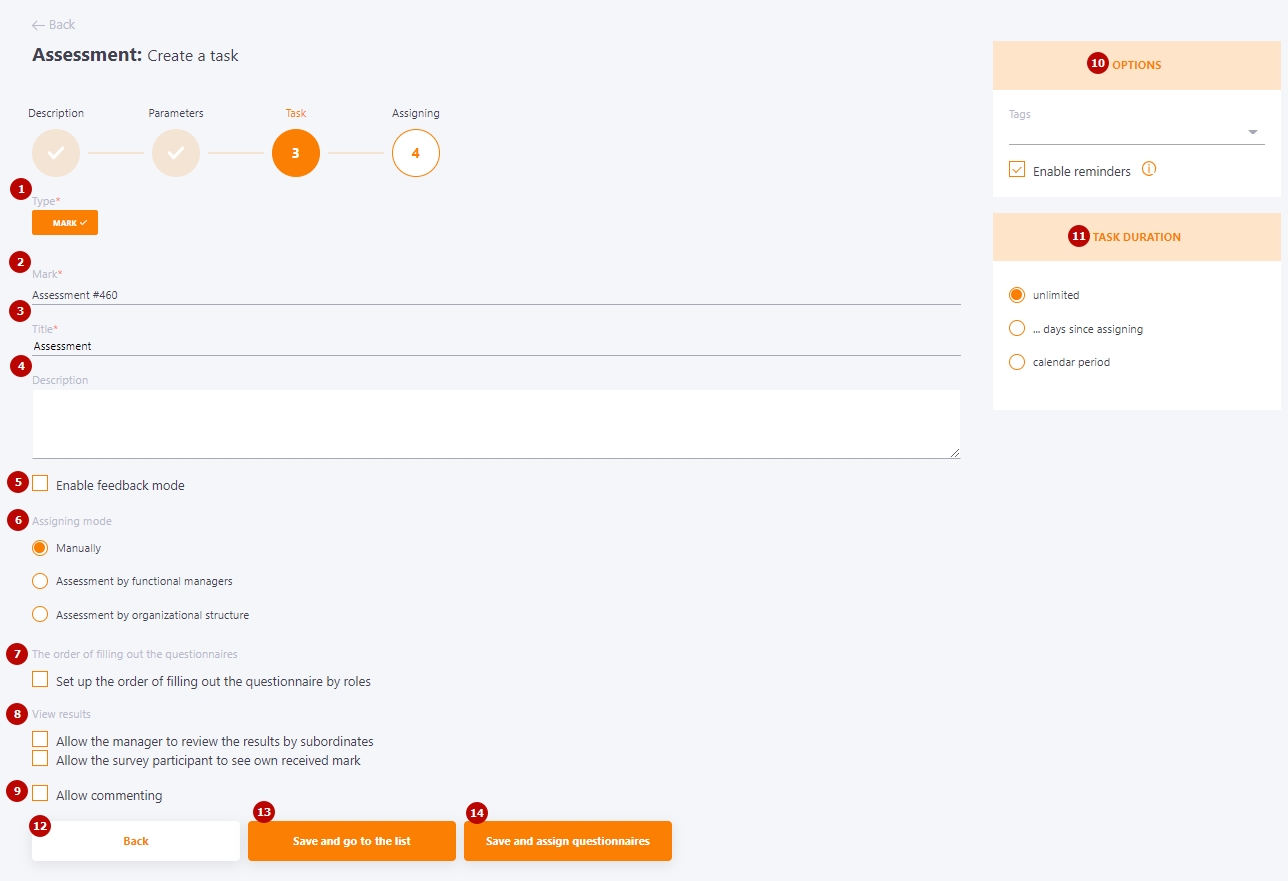
(1) Type - by default, Mark is selected as the task type in the wizard.
(2) Mark - the assessment created at the previous stages is immediately selected.
(3) Title - this field is automatically filled with the name of the assessment, it can be changed if necessary. Required field, cannot be empty.
(4) Description - the field is automatically filled with a description of the assessment, it can be changed if necessary.
(5) Enable feedback mode - this function is used when it is necessary to conduct an assessment in the format of collecting feedback. Read more about this function in the article - Passing an assessment task.
(6) Assigning mode - the method in which the questionnaires will be assigned to the tasks.
The following options are available:
- manually;
- assessment by functional managers;
- assessment by organizational structure.
Read more about each mode of questionnaire assignment in the article Creating and editing an assessment task.
(7) The order of filling out the questionnaires - by default, all assigned assessment questionnaires can be filled out by respondents independently of each other. But using this feature, you can customize the order of filling out the questionnaires by role. Read more about the option to customize the order of filling out the questionnaires in the article Creating and editing an assessment task.
(8) View results - options that provide access to the manager to see the result of the evaluation of subordinates, and the participant to see how he was evaluated. Access is provided to the report without specifying the names of respondents.
(9) Allow commenting - the option enables the ability to comment on tasks.
(10) Options block:
- the ability to specify a tag for the task
- the option Enable reminders - If the option is enabled, users assigned to the task will be sent reminders that they have failed or missed this task. You can configure the sending time and frequency of reminders in the "Tasks Reminder" menu on the task list page.
(11) Task duration - setting the deadline for completing the assessment task. Read more about this setting in the article Creating and editing an assessment task.
(12) Back - button returns to the 2nd stage of the wizard without saving the data filled in at the 3rd stage.
(13) Save and go to the list - the assessment task is saved and you go to the list of all tasks. In this case, the wizard will be completed. To assign a task with an assessment, you will need to go to the task assignment page.
(14) - Save and assign questionnaires - transition to the stage of assigning the created task.
Stage 4 - Questionnaire assignment
At the 4th stage of the wizard's work, you need to assign questionnaires for participants to fill out.
The algorithm for assigning questionnaires depends on the mode of questionnaire assignment selected at stage 3.
- If the assignment mode manually is selected - it is necessary for each questionnaire to select the evaluated, the respondent and the role in which he will evaluate the questionnaire (add an assignment - button (1)). Alternatively, you can assign users as a list from a File (2).

- If assessment by functional managers or assessment by organizational structure is selected, it is enough to assign users to be assessed and the system will automatically assign questionnaires to respondents according to the relationships of the organizational structure or functional managers.
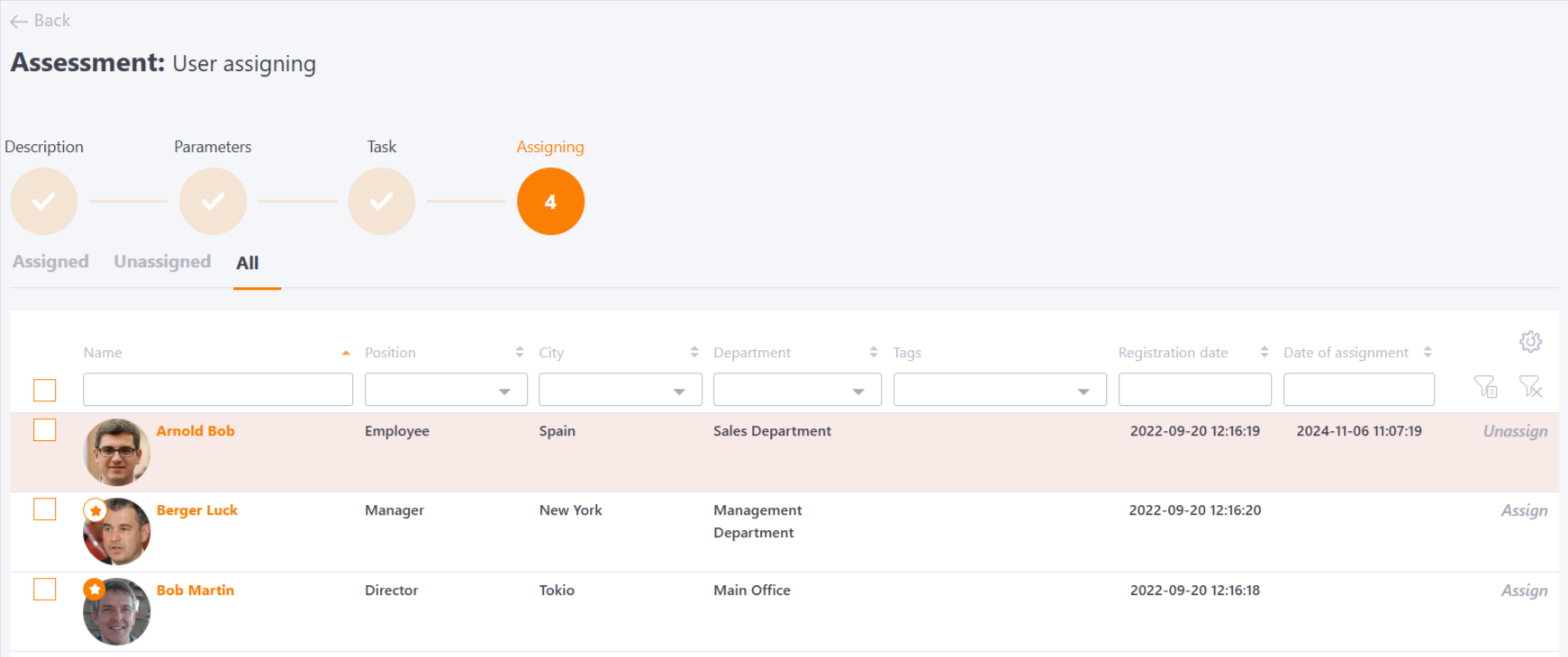
During the assignment of questionnaires, all respondents will receive a notification by Assessment - A questionnaire has been assigned to a user.
Details about the process of assigning questionnaires are described in the article Task-assessment assignment.
The process of completing the questionnaires is described in the article Passing an assessment task.
Viewing reports of the assessment by criteria is described in the article Evaluation report and viewing the results of the assessment by criteria.
